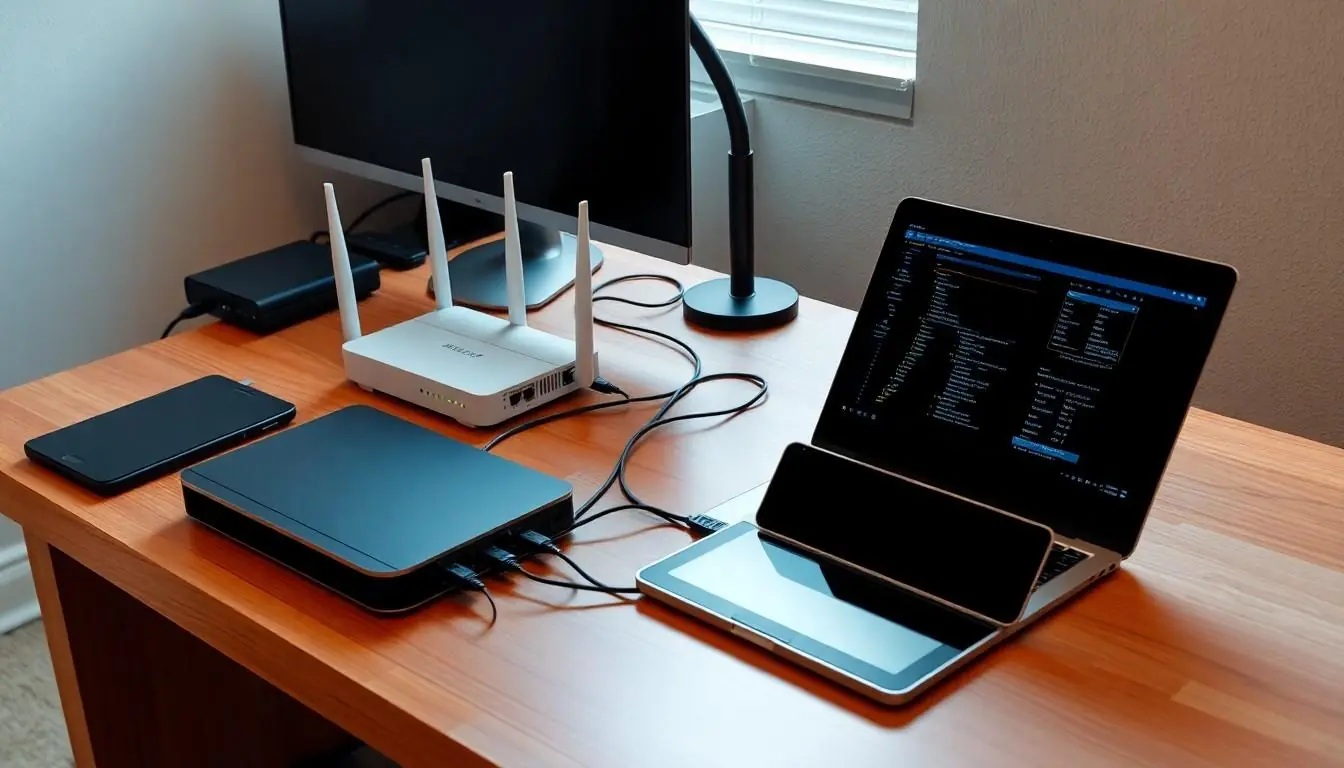In a world where Wi-Fi is as essential as coffee, navigating home networking can feel like trying to solve a Rubik’s Cube blindfolded. From buffering movies to mysterious dead zones, the struggle is real. But fear not! Home networking doesn’t have to be rocket science. With a little guidance, even the most tech-challenged can transform their living space into a seamless digital haven.
Understanding Home Networking
Home networking connects devices through wired or wireless connections. This setup facilitates communication and data sharing between computers, smartphones, smart TVs, and other devices.
What Is Home Networking?
Home networking refers to the arrangement that allows multiple devices to connect and communicate within a residence. It typically includes routers, switches, and access points. These components work together to create a seamless network experience. Devices can access the internet and share files without physical connections. Understanding network protocols like TCP/IP also helps in optimizing these connections.
Importance of Home Networking
Effective home networking enhances digital experiences for all users. A reliable network reduces buffering and improves streaming quality. It also allows for secure file sharing between devices. Smart home devices, like thermostats and security cameras, depend on a robust network to function properly. Increased productivity results from better connectivity in remote work setups. Home networking simplifies online gaming, making it more enjoyable.
Key Components of Home Networking


Home networking relies on several essential components to function effectively. Understanding these parts enables better connectivity and performance for all devices in a residence.
Routers and Modems
Routers and modems serve as the backbone of a home network. A modem connects the home to the internet, translating data from the service provider. It creates a pathway for the router, which distributes the internet connection to multiple devices. Routers manage traffic within the network, preventing data collisions. Each network device relies on a router to access the internet. Many modern devices incorporate both functions into a single unit called a gateway. This combination simplifies setup and minimizes equipment clutter.
Switches and Access Points
Switches and access points enhance home networks significantly. Switches connect multiple devices to a router via Ethernet cables, allowing for faster and more reliable connections. They intelligently direct data to the intended device without delays. Access points extend Wi-Fi coverage throughout a home, reducing dead zones. Placing access points strategically increases wireless connectivity and capacity. Some devices even offer dual-band support, enabling a smoother experience for streaming and gaming. Together, switches and access points create a robust home network that meets various user needs.
Setting Up Your Home Network
Setting up a home network involves selecting suitable equipment and following an installation guide for optimal performance. Understanding these factors makes the process easier.
Choosing the Right Equipment
Selecting the appropriate equipment ensures a smooth home networking experience. Begin with a reliable modem, which connects to the internet, followed by a router to distribute the signal. Look for dual-band or tri-band routers that enhance speed and reduce interference. Incorporate switches if multiple wired connections are necessary. Consider access points to extend Wi-Fi coverage in larger homes. Research product reviews and specifications to find equipment that meets specific digital demands.
Step-by-Step Installation Guide
Follow a series of steps for a successful home network installation. Start by connecting the modem to a power outlet and the internet source. Next, connect the router to the modem using an Ethernet cable. Then, power on the router and allow it to boot up. Configure the router through its web interface, setting a unique network name and password. If needed, connect switches or access points using additional Ethernet cables. Finally, test the network by connecting devices and checking internet access for performance.
Common Home Networking Issues
Home networks face several common challenges that can disrupt connectivity and performance. Understanding these issues aids in creating a smoother digital experience.
Troubleshooting Connectivity Problems
Start by checking the network connection. A device may not connect due to a weak Wi-Fi signal or firmware issues. Restarting the router often resolves temporary glitches in connectivity. If the problem persists, examine the device settings for incorrect configurations. Inspecting physical connections like Ethernet cables can identify potential loose links. In some cases, network congestion from too many devices accessing the network simultaneously contributes to connectivity issues. Resetting the router to factory settings can restore functionality if all else fails.
Tips for Improving Network Performance
Enhancing network performance involves several strategies. Position the router centrally to maximize coverage in all areas of the home. Upgrading to dual-band or tri-band routers can reduce interference from competing devices operating on similar frequencies. Incorporating access points or Wi-Fi extenders can eliminate dead zones by amplifying the signal. Regularly updating the router’s firmware helps maintain optimal security and performance. Limiting bandwidth-heavy activities during peak usage times can also improve overall network responsiveness.
Security Considerations
Securing a home network protects personal data and devices. Understanding key security practices helps maintain a safe online environment.
Protecting Your Home Network
Network protection begins with changing default passwords. Most devices come with generic passwords that are easy for hackers to guess. Enabling WPA3 encryption further secures your Wi-Fi connection, making it more difficult for unauthorized users to access. Regularly updating router firmware can also patch vulnerabilities and enhance security features. Adding a firewall provides an extra layer of protection against external threats, preventing unauthorized access. Utilizing a guest network for visitors keeps the main network secure by isolating devices. Finally, monitoring connected devices helps identify any unauthorized access quickly.
Best Practices for Network Security
Employing strong passwords remains essential for network security. Passwords should include a mix of uppercase and lowercase letters, numbers, and special characters. Limiting remote management access on the router greatly minimizes potential exploitation risks. Regularly reviewing connected devices enables users to detect suspicious activity, ensuring any unauthorized access is addressed swiftly. Keeping software up-to-date maintains security against known vulnerabilities. Educating household members on recognizing phishing attempts also proves crucial, as it helps prevent accidental sharing of sensitive information. Lastly, consider using a Virtual Private Network (VPN) for an added layer of privacy during internet browsing.
Mastering home networking is essential for anyone looking to enhance their digital experience. With the right equipment and setup, anyone can create a reliable network that supports all their devices. Tackling common issues like buffering and dead zones becomes manageable with the right knowledge and tools.
Security shouldn’t be overlooked either. Protecting personal data and ensuring a secure connection is vital in today’s digital landscape. By following best practices and staying informed, anyone can enjoy seamless connectivity and peace of mind at home. Embracing these strategies will lead to a more efficient and enjoyable online experience for everyone in the household.





